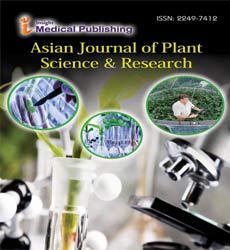ISSN : 2249 - 7412
Asian Journal of Plant Science & Research
Plant Regular Items: The Atomic Hereditary Premise of Biosynthetic Variety
Yihua Zhou*
Department of Plant Genomics, Institute of Genetics and Developmental Biology, Beijing, China
*Corresponding Author:Yihua Zhou
Department of Plant Genomics, Institute of Genetics and Developmental Biology, Beijing, China
E-mail:Zhou_Yi@med.CN
Received date: January 26, 2022, Manuscript No. AJPSKY-22-12702; Editor assigned date: January 28, 2022, PreQC No. AJPSKY-22-12702 (PQ); Reviewed date: February 07, 2022, QC No. AJPSKY-22-12702; Revised date: February 17, 2022, Manuscript No. AJPSKY-22-12702 (R); Published date: February 28, 2022, DOI: 10.36648/2249-7412.12.2.007.
Citation: Zhou Y (2022) Plant Regular Items: The Atomic Hereditary Premise of Biosynthetic Variety. Asian J Plant Sci Res Vol.12 No.2: 007.
Description
STB is among the parasitic infection which compromises wheat creation and it's accounted for to be significant wheat creation undermine factor overall causing extensive yield misfortune consistently. It is a financially significant foliar illness in the significant wheat-developing areas of Ethiopia. This examination was directed during 2019/2020 at dabat research station under gondar agrarian exploration community. The examination was led to propel high yielding and septoria safe bread wheat assortments appropriate for concentrated on conditions. The test field was planned in basic cross section plan with two replications and 100 genotypes utilized as treatment. The investigation of fluctuation showed an exceptionally huge contrast for a large portion of the endlessly yield contributing qualities among the tried genotypes. Out of 100 genotypes, 60 were viewed as reasonably safe and forty were in the scope of decently defenseless. Region under progress bend AUDPC esteem was determined for a really long time to heading, grain filling period, days to development, plant tallness, spike length, spikelets per spike portions per spike, thousand seed weight, and grain yield [1,2].
Improvement of Wheat Assortments
Wheat is one of the significant grain harvests of the world alongside rice and maize. It is developed on more land region than some other business food. As indicated by FAO, world wheat creation in 2017 was 756.8 million tons which were decreased when contrasted with 2016 which was 757.2 million tons. Wheat creation obliged by different biotic and abiotic factors. Among the biotic variables, parasitic illnesses are perhaps the main biotic requirement undermining wheat creation in Ethiopia [3]. As of late, rusts (stem yellow and leaf rust) and septoria leaf smear and fusarium head curse are fundamentally undermining wheat creation in a large portion of the wheat-delivering agro-ecologies.
STB is among the parasitic infections which compromise wheat creation and it is accounted for to be significant wheat creation undermining factor overall causing extensive yield misfortune consistently [4]. STB happens in wheat-creating region of all mainland's and results in genuine harvest misfortunes in numerous wheat-developing districts of the world with crop misfortunes in certain areas, like North Africa and southern Brazil, being destroying. The illness causes genuine yield misfortune and misfortunes credited to a weighty invasion in fields planted with wheat defenseless cultivars have been accounted for to go from 30% to 40%. Pestilences can be especially crushing in non-industrial nations, like those in East Africa, and extreme pandemics of STB can decrease wheat yields by 35 to half to ease these limitations testing wheat creation, wheat rearing project wheat raisers have been chipping away at the improvement of wheat assortments with high return potential and protection from significant wheat sicknesses. The advancement of high yielding assortments requires careful information on the current hereditary variety for yield and its parts.
Ecological Variables of Developing
The effective course of wheat rearing depends on the information on attributes of genotypes, climate and association. The ideal cultivar for high grain yield or for some other helpful characteristics needs to communicate hereditary potential with the low worth of change in various ecological variables of developing.
Hence, the target of this study was to propel high yielding and septoria safe bread wheat assortments reasonable for concentrated on conditions 100 bread wheat genotypes were contemplated including standard and neighborhood checks. There was a profoundly huge contrast among the genotypes for a really long time to heading, grain filling period, days to development, plant tallness, grain yield, thousand seed weight, spike length, spikes quantities of spikelets per spike and Kernels per spike [5]. The critical contrast among genotypes for the characteristics shows that there was the presence of hereditary variety among the genotypes which thus proposes that choice of lines can be compelling in working on both yield and quality attributes. The primary goal of this examination was to distinguish/screen the genotypes which are obstruction/resilience to wheat infection especially for septoria dull smudge and rust sicknesses also high grain yield was fundamental. The illness information were recorded at various phases of wheat development (to assess the sickness event time and yield misfortune), in view of this two fold digit technique is the most effective way to score septoria dull smear. The vast majority of the genotypes are gone from 15%-35%, which shows that the genotypes reaction to sicknesses is impervious to direct obstruction [6].
In this examination, an adequate measure of hereditary inconstancy was seen in the germplasm promotions for septoria illness response. Based on discoveries, increases were gathered into moderate protection from modestly defenseless classifications under field conditions. The genotypes showing low AUDPC values were considered as obstruction and high AUDPC as vulnerable [7]. The negative relationship between AUDPC esteem and significant yield parts uncovered its effect on endlessly yield contributing characteristics. From 100 genotypes including nearby and standard check, sixty were viewed as respectably safe including standard check and forty genotypes including neighborhood check were viewed as tolerably vulnerable to septoria tritici smear. This outcome drives us to direct further exploration to actually take a look at more opposition and resilience capacity of various genotypes. Consequently, this data from the concentrated on characteristics and sickness assessment among various genotypes demonstrated that there was viewed as high existing hereditary variety among genotypes. In view of this data, infection, endlessly yield contributing attributes and field stand appraisal 28 genotypes were progressed to the following rearing advance PYT [8,9].
This might be a result of the decreased photosynthetic region of the plant to absorb the sugar in seed because of the infected leaf. Most yield concentrates on septoria tricitici smear showed connections between illness seriousness on the upper one and three leaves and yield. The most serious gamble to a harvest is the event of conditions that favor spore dispersal during and not long after banner leaf development that crop misfortunes are connected with all out leaf region contaminated including necrotic injury and chlorotic chips. A few genotypes have high AUDPC worth and give a sensible yield; it could be proposed that genotypes were more opposition and resilience [10].
References
- Wegener PL, Lahr Daniel JG, Andrew KH, Laura KA (2011) Estimating the timing of early eukaryotic diversification with multigene molecular clocks. Proc Natl Acad Sci 108: 1362-13629. [Crossref], [Google Scholar]
- Mack LM, Barker M, Carpenter E, Deyholos MK, Gitzendammer MA, et al. (2019) One thousand plant transcriptomes and the phylogenomics of green plants. Nature 574: 679-685. [Crossref], [Google scholar]
- Field CB, Behrenfeld MJ, Randerson JT, Falkowski P(1998) Primary production of the biosphere: Integrating terrestrial and oceanic components. Science 281: 237-240. [Crossref], [Google scholar], [Indexed]
- Lewis LA, McCourt RM (2004) Green algae and the origin of land plants. Am J Bot 91: 1535-1556. [Crossref], [Google scholar], [Indexed]
- Paul SK, Leila B, Martin BD, Charles WH (2011) Earth's earliest non-marine eukaryotes. Nature 473: 505-509. [Crossref], [Google scholar], [Indexed]
- Matthias E, Nathalie V, Robert Christelle AM, Hao X, Monika F, et al. (2015) Indole is an essential herbivore-induced volatile priming signal in maize. Nat Commun 6: 6273. [Crossref], [Google scholar]
- Bishop MJ, Hutchings PA (2011) How useful are port surveys focused on target pest identification for exotic species management. Mar Pollut Bull 62: 36-42. [Crossref], [Google scholar], [Indexed]
- McCullough, Deborah G, Work TT, Cavey JF, Liebhold AM, et al. (2006) Interceptions of nonindigenous plant pests at US ports of entry and border crossings over a 17-year Period. Biol Invasions 8: 611-630 [Crossref], [Google Scholar]
- Johansson E, Hammarsk F, Lundberg D, Arnlind MH (2013) Advantages and disadvantages of PICC compared to other central venous lines: A systematic review of the literature. Acta Oncol 52: 886-892.†[Crossref], [Google scholar], [Indexed]
- Rajeev DS, Sheela V (2017) Peripheral venous pressure: An alternative to central venous pressure. J med sci clin res 83: 2455-0450. [Crossref], [Google scholar], [Indexed]

Open Access Journals
- Aquaculture & Veterinary Science
- Chemistry & Chemical Sciences
- Clinical Sciences
- Engineering
- General Science
- Genetics & Molecular Biology
- Health Care & Nursing
- Immunology & Microbiology
- Materials Science
- Mathematics & Physics
- Medical Sciences
- Neurology & Psychiatry
- Oncology & Cancer Science
- Pharmaceutical Sciences
